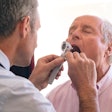Researchers from the Duke Cancer Institute and the University of Chicago have found a way to identify patients with recurring head and neck cancer who are most likely to benefit from a second round of chemotherapy and radiation, according to new study in the journal Cancer (June 13, 2011).
The finding could spare many cancer patients from undergoing an intervention that may add to their suffering, fail to prolong life, and even be lethal, according to the researchers. A second round of treatment is potentially deadly, but provides a two-year cure for about 25% of patients.
"The second round of treatment is difficult -- you've used up the good graces of the body with the first round," said senior author Joseph Salama, MD, a radiation oncologist at Duke. "So we were looking for predictors as to who did well with this to try to prevent people from [experiencing] unnecessary side effects."
The researchers analyzed 166 patients who had undergone intensive chemotherapy and radiation by the University of Chicago head and neck cancer team when their tumors reappeared.
They identified four characteristics that correlated to better outcomes with the repeat therapy. One of the most significant factors was whether patients received both chemotherapy and radiation when their tumors first appeared. Patients who got radiation alone had a far better chance of surviving the second round of combination therapy than those who initially got the dual treatment.
Dr. Salama said it may be that the recurring tumors had developed resistance from the initial course of chemotherapy, foiling the benefits of further treatment. Patients also had a better chance of a second-round cure if they had an extended period of remission before the tumor reappeared, could withstand a higher dose of radiation during the repeat therapy, and were able to undergo surgery to remove part or all of the new malignancy.
Outcomes were best among patients who met all four of the criteria, with 63% surviving at least two years.
"The treatment is potentially curative, but it's quite toxic, so when someone is embarking upon this treatment, they need to be counseled appropriately," Dr. Salama said, noting that the intervention can diminish the quality of life.
The therapy can damage the mouth and esophagus, and most patients lose the ability to swallow solid foods. The voice box can also be damaged, rendering patients mute.
Some 20% of patients in the study group died as a result of the treatment. But other options are equally grim. Chemotherapy alone can shrink the returning malignancy, but doesn't cure it, while surgical removal of the tumor is often impossible.
"We can better pick who can benefit from this treatment, but that being said, we need to come up with better treatments," Dr. Salama said.
Head and neck cancers, including cancers of the mouth, pharynx, and sinuses, represent about 3% of all malignancies in the U.S., according to the National Cancer Institute. The cancers are primarily linked to smoking and chewing tobacco.



















